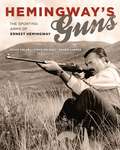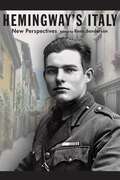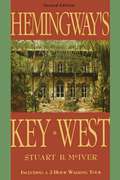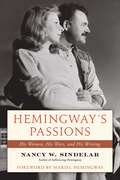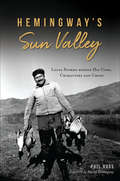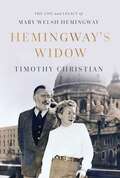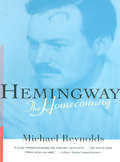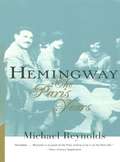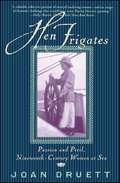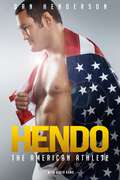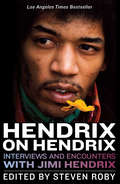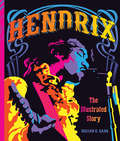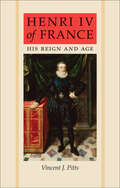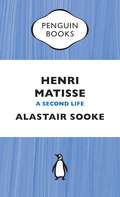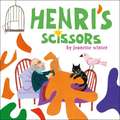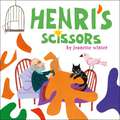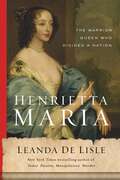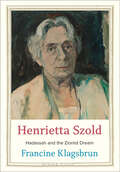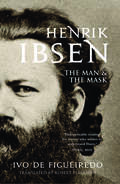- Table View
- List View
Hemingway's Guns: The Sporting Arms of Ernest Hemingway
by Silvio Calabi Steve Helsley Roger SangerErnest Hemingway is a mythic writer and alpha male. As a hunter and conservationist, he drew greatly from the strong example of Theodore Roosevelt, and he much enjoyed teaching newcomers to shoot and hunt. Including short excerpts from Hemingway's works, these stories of his guns and rifles tell us as much about him as a lifelong, expert hunter and shooter and as a man.
Hemingway's Havana: A Reflection of the Writer's Life in Cuba
by Robert Wheeler América FuentesErnest Hemingway lived in Cuba for more than two decades, longer than anywhere else. He bought a home—naming it the Finca Vigia—with his third wife, Martha Gellhorn and wrote his masterpiece The Old Man and the Sea there. In Cuba, Papa Hemingway found a sense of serenity and enrichment that he couldn’t find anywhere else. Now, through more than a hundred color photographs and accompanying text, Robert Wheeler takes us through the streets and near the water’s edge of Havana, and closer to the relationship Hemingway shared with the Cuban people, their landscape, their politics, and their culture. Wheeler has followed Hemingway’s path across continents—from La Closerie des Lilas Café in Paris to Sloppy Joe’s Bar in Key West to El Floridita in Havana—seeking to capture through photography and the written word the essence of one of the greatest writers in the English language. In Hemingway’s Havana, he reveals the beauty and the allure of Cuba, an island nation whose deep connection with the sea came to fascinate and inspire the writer. The book includes a foreword by América Fuentes who is the granddaughter of the late Gregorio Fuentes, the captain of Hemingway’s boat Pilar and his loyal and close friend.
Hemingway's Italy: New Perspectives
by Rena SandersonIn 1918, a one-month stint with the American Red Cross ambulance corps at the Italian front marked the beginning of Ernest Hemingway's fascination with Italy--a place second only to Upper Michigan in stimulating his lifelong passion for geography and local expertise. Hemingway's Italy offers a thorough reassessment of Italy's importance in the author's life and work during World War I and the 1920s, when he emerged as a promising young writer, and during his maturity in the late 1940s and early 1950s. This collection of eighteen essays presents a broad view of Hemingway's personal and literary response to Italy. The contributors, some of the most distinguished Hemingway scholars, incorporate new biographical and historical information as well as critical approaches ranging from formalist and structuralist theory to cultural and interdisciplinary explorations. Included are discussions of Italy's psychological functioning in Hemingway's life, the author's correspondence with his father during the writing of A Farewell to Arms, his stylistic experimentation and characterization in that novel, his juxtaposition of the themes of love and war, and his take on Fascism in both his fiction and journalistic work. In addition, the essayists explore relevant contexts of period and place--such as the rise of Fascism, ethnic attitudes, and the cultural currents between Italy and the United States. A landmark study, Hemingway's Italy brings long-overdue attention to this great writer's international role as cultural ambassador. Contributors: Rena Sanderson, Nancy R. Comley, Kim Moreland, Steven Florczyk, Kirk Curnutt, Lawrence H. Martin, John Robert Bittner, Joseph M. Flora, Jeffrey A. Schwarz, J. Gerald Kennedy, H. R. Stoneback, Beverly Taylor, Ellen Andrews Knodt, Linda Wagner-Martin, Robert Fleming, Miriam B. Mandel, Margaret O'Shaughnessey, Stephen L. Tanner, Vita Fortunati
Hemingway's Key West
by Stuart B McIverThe only place in the United States that Hemingway could really call home after he started writing was the tropical island of Key West. During his decade here in the 1930s, he acquired his famed macho persona as Papa, the biggest Big Daddy of them all. This vivid portrait of Ernest Hemingway's Key West reveals both Hemingway, the writer, and Hemingway, the macho, hard-drinking sportsman. His Key West years turned out to be his most productive: he finished A Farewell to Arms, started For Whom the Bell Tolls, and wrote several other books, including Green Hills of Africa, Death in the Afternoon, and To Have and Have Not. He also turned out some of his best short stories. There was plenty of time left over for eating, drinking, fighting, fishing, chasing women, and hanging out with his circle of friends (known as "the Mob"). Hemingway spent the last years of his life in Cuba, and it was here he overcame several demons—accidents, failing health, depression—to write The Old Man and the Sea, for which he won both a Pulitzer and a Nobel Prize in Literature.Filled with photos (some of which were not available in the first edition), this book also includes a two-hour walking tour of Key West and a tour of Hemingway's favorite Cuban haunts. This edition also includes a record of the author's exploits in Bimini and Cuba. Accompany Hemingway on fishing expeditions in the Gulf Stream and to Cuba and Bimini aboard his custom-built boat, Pilar. A treat for Hemingway fans!
Hemingway's Passions: His Women, His Wars, and His Writing
by Nancy W. SindelarA provocative and unique look at how the women Hemingway loved shaped this literary legend Ernest Hemingway&’s passion was writing, and he was inspired by a lifetime of daring adventures and encouraged by the many women in his life. He nurtured his creativity by purposely seeking dangerous situations to test his own levels of courage and to create literary heroes who displayed grace under pressure. His masculine, adventurous spirit appealed to women of all ages, including four wives and a long list of legendary actresses, and he frequently transformed the women in his life into memorable fictional characters.In 1950, Hemingway told Marlene Dietrich that he truly loved only five women. Who were these women and why did he love them? Some of them may have included his wives—Hadley Richardson, Pauline Pfeiffer, Martha Gellhorn, and Mary Welsh—but there were others too, among them Agnes von Kurowsky. Through quotations from his works and personal letters, as well as more than sixty photographs—many of which have not been previously published—Hemingway scholar Nancy W. Sindelar captures Hemingway&’s life and romantic adventures, revealing his own feelings about his romantic relationships and the ways his experiences with women appear in his literary works.Much has been written about Hemingway, but to date no book has linked the women he loved to his written work. The stories of Hemingway&’s romantic relationships reveal not only the influence these women had on his writing but also his personal ambition, heartbreak, and literary triumphs and trials. Sindelar&’s provocative analyses of Hemingway&’s literature give fresh insight into the life of a legendary author, outdoorsman, adventurer, and lover.Includes 60 photographs, many never previously published.
Hemingway's Student
by Paul HendricksonFrom the award-winning biography of Ernest Hemingway, Hemingway's Boat: the poignant story of Arnold Samuelson, who looked to the great author for mentorship in writing and life. He was a Midwesterner, a young journalist, haunted by inner demons, with a rambling gene, who headed down to Key West and was keen to establish his place in the pantheon of American writers. This was not Papa but Arnold Samuelson, a tormented and scarred young man who pocketed a newspaper photograph of his hero and role model and set off to find him in May of 1934. As luck would have it, Hemingway was home: he was in need of assistance on his new boat, Pilar, and happy to dole out writing advice between fishing and beers. This is the story of Hemingway the teacher, a rare glimpse of Hemingway sharing his craft--part education of a writer and part shadow story of a man who wanted to be Hemingway, and what that meant for him.
Hemingway's Sun Valley: Local Stories behind His Code, Characters and Crisis
by Phil HussA Hemingway expert shares untold stories of the writer&’s life in Idaho, together with passages from his works, to shed light on the ideals he lived by. It was a cold, "windless, blue sky day" in the fall of 1939 near Silver Creek—a blue-ribbon trout stream south of Sun Valley. Ernest Hemingway flushed three mallards and got each duck with three pulls. He spent the morning working on his novel For Whom the Bell Tolls. Local hunting guide Bud Purdy attested, "You could have given him a million dollars and he wouldn't have been any happier." In Hemingway&’s Sun Valley, Phil Huss delves into previously unpublished stories about Hemingway's adventures in Idaho. Each chapter is devoted to a principle of the author's Heroic Code, such as Complete Tasks Well, Embrace the Present, and Avoid Self-Pity. Combining true stories and literary passages, this book reveals how Hemingway&’s life and work embody this code.
Hemingway's Widow: The Life and Legacy of Mary Welsh Hemingway
by Timothy ChristianA stunning portrait of the complicated woman who becomes Ernest Hemingway's fourth wife, tracing her adventures before she meets Ernest, exploring the tumultuous years of their marriage, and evoking her merry widowhood as she shapes Hemingway's literary legacy.Mary Welsh, a celebrated wartime journalist during the London Blitz and the liberation of Paris, meets Ernest Hemingway in May 1944. He becomes so infatuated with Mary that he asks her to marry him the third time they meet—although they are married to other people. Eventually, she succumbs to Ernest's campaign, and in the last days of the war joined him at his estate in Cuba. Through Mary's eyes, we see Ernest Hemingway in a fresh light. Their turbulent marriage survives his cruelty and abuse, perhaps because of their sexual compatibility and her essential contribution to his writing. She reads and types his work each day—and makes plot suggestions. She becomes crucial to his work and he depends upon her critical reading of his work to know if he has it right. We watch the Hemingways as they travel to the ski country of the Dolomites, commute to Harry's Bar in Venice; attend bullfights in Pamplona and Madrid; go on safari in Kenya in the thick of the Mau Mau Rebellion; and fish the blue waters of the gulf stream off Cuba in Ernest's beloved boat Pilar. We see Ernest fall in love with a teenaged Italian countess and wonder at Mary's tolerance of the affair. We witness Ernest's sad decline and Mary's efforts to avoid the stigma of suicide by claiming his death was an accident. In the years following Ernest's death, Mary devotes herself to his literary legacy, negotiating with Castro to reclaim Ernest's manuscripts from Cuba, publishing one-third of his work posthumously. She supervises Carlos Baker's biography of Ernest, sues A. E. Hotchner to try and prevent him from telling the story of Ernest's mental decline, and spends years writing her memoir in her penthouse overlooking the New York skyline. Her story is one of an opinionated woman who smokes Camels, drinks gin, swears like a man, sings like Edith Piaf, loves passionately, and experiments with gender fluidity in her extraordinary life with Ernest. This true story reads like a novel—and the reader will be hard pressed not to fall for Mary.
Hemingway's Widow: The Life and Legacy of Mary Welsh Hemingway
by Timothy ChristianA stunning portrait of the complicated woman who was Ernest Hemingway’s fourth wife, exploring the tumultuous years of their marriage, and evoking her merry widowhood as she shapes Hemingway’s literary legacy.Mary Welsh, a celebrated wartime journalist during the London Blitz and the liberation of Paris, meets Ernest Hemingway in May 1944. He becomes so infatuated with Mary that he asks her to marry him the third time they meet, even though they are married to other people. Eventually, she succumbs to Ernest’s campaign and, in the last days of the war, joins him at his estate in Cuba.Through Mary’s eyes, we see Ernest Hemingway in a fresh light. Their turbulent marriage survives his cruelty and abuse, perhaps because of their sexual compatibility and her essential contribution to his writing. She reads and types his work each day and makes plot suggestions. She becomes crucial to his work and he depends upon her critical reading of his writing to know if he has it right.We watch the Hemingways as they travel to the ski country of the Dolomites; commute to Harry’s Bar in Venice; attend bullfights in Pamplona and Madrid; go on safari in Kenya in the thick of the Mau Mau rebellion; and fish the blue waters of the gulf stream off Cuba in Ernest’s beloved boat Pilar. We see Ernest fall in love with a teenaged Italian countess and wonder at Mary’s tolerance of the affair.We witness Ernest’s sad decline and Mary’s efforts to avoid the stigma of suicide by claiming his death was an accident. In the years following Ernest’s death, Mary devotes herself to his literary legacy, negotiating with Castro to reclaim Ernest’s manuscripts from Cuba and publishing one-third of his work posthumously. She supervises Carlos Baker’s biography of Ernest, sues A.E. Hotchner to try and prevent him from telling the story of Ernest’s mental decline, and spends years writing her memoir in her penthouse overlooking the New York skyline.Her story is one of an opinionated woman who smokes Camels, drinks gin, swears like a man, sings like Edith Piaf, loves passionately, and experiments with gender fluidity in her extraordinary life with Ernest. This true story reads like a novel, and the reader will be hard pressed not to fall for Mary.
Hemingway: The 1930s through the Final Years (Movie Tie-in Edition) (Movie Tie-in Editions)
by Michael ReynoldsPublished to coincide with the major release of HBO's upcoming film Hemingway and Gellhorn, starring Nicole Kidman and Clive Owen. Michael Reynolds was the supreme biographer of Ernest Hemingway. HBO's film concentrates on Hemingway's years with his third wife, the adventurous journalist Martha Gellhorn. This book brings together Reynolds's Hemingway: The 1930s and Hemingway: The Final Years.
Hemingway: The Homecoming
by Michael ReynoldsThe 1920s in Paris are the pivotal years in Hemingway's apprenticeship as a writer, whether sitting in cafes or at the feet of Gertrude Stein. These are the heady times of the Nick Adams short stories, Fitzgerald's The Great Gatsby, and the writing of The Sun Also Rises. These are also the years of Hemingway's first marriage to Hadley Richardson, the birth of his first son, and his discovery of the bullfights at Pamplona.
Hemingway: The Paris Years
by Michael ReynoldsThe 1920s in Paris are the pivotal years in Hemingway's apprenticeship as a writer, whether sitting in cafés or at the feet of Gertrude Stein. These are the heady times of the Nick Adams short stories, Fitzgerald's The Great Gatsby, and the writing of The Sun Also Rises. These are also the years of Hemingway's first marriage to Hadley Richardson, the birth of his first son, and his discovery of the bullfights at Pamplona.
Hen Frigates: Passion and Peril, Nineteenth-century Women at Sea
by Joan DruettA "hen frigate," traditionally, was any ship with the captain's wife on board. Hen frigates were miniature worlds -- wildly colorful, romantic, and dangerous. Here are the dramatic, true stories of what the remarkable women on board these vessels encountered on their often amazing voyages: romantic moonlit nights on deck, debilitating seasickness, terrifying skirmishes with pirates, disease-bearing rats, and cockroaches as big as a man's slipper. And all of that while living with the constant fear of gales, hurricanes, typhoons, collisions, and fire at sea. Interweaving first-person accounts from letters and journals in and around the lyrical narrative of a sea journey, maritime historian Joan Druett brings life to these stories. We can almost feel for ourselves the fear, pain, anger, love, and heartbreak of these courageous women. Lavishly illustrated, this breathtaking book transports us to the golden age of sail.
Hendo: The American Athlete
by Dan Henderson David KanoA riveting memoir by the first MMA double champion and two-time Olympic wrestler who cut a polarizing path as a firebrand figure and went on to become a legend.&“Dan Henderson is a savage. He came from a pure, wrestling background with very little striking training, and he went and became one of the most dangerous, one-punch knockout artists in the history of the sport.&” —Joe Rogan Dan &“Hendo&” Henderson was the first fighter in MMA history to become a double champion, winning championships in PRIDE Fighting Championships and Strikeforce. He faced the biggest names in MMA, on his unparalleled run through the early days of MMA through its remarkable rise in popularity, squaring off against the likes of Fedor Emelianenko, Anderson Silva, Quinton &“Rampage&” Jackson, Wanderlei Silva, Michael Bisping, Vitor Belfort, and Renzo Gracie. Henderson&’s first fight against Mauricio &“Shogun&” Rua in 2011 is considered one of the greatest fights in UFC history. In this no-holds-barred look back on his life, Henderson provides context and insight into the biggest fights of his career, while reflecting on the wholly unique upbringing that shaped him into the warrior he needed to be to win. With his trademark humor, he sheds light on his two trips to the Olympics, his transformative time training in Europe and Russia, and his up-and-down relationship with Dana White. Hendo: The American Athlete is a thrilling window into the life and mind of a true legend. There will never be another fighter like Hendo.
Hendrix on Hendrix: Interviews and Encounters with Jimi Hendrix
by Steven RobyThough many books have chronicled Jimi Hendrix's brilliant but tragically brief musical career, this is the first to use his own words to paint a detailed portrait of the man behind the guitar. With selections carefully chosen by one of the world's leading Jimi Hendrix historians, this work includes the most important interviews from the peak of his career, 1966 to 1970. In this authoritative volume, Hendrix recalls for reporters his heartbreaking childhood, his concept of "Electric Church Music" (intended to wash people's souls and give them a new direction), and his wish to be remembered as not just another guitar player. While Hendrix never wrote a memoir, with new transcriptions from European papers, the African American press, counterculture newspapers, radio and TV interviews, and previously unpublished court transcripts, this book gives music fans the next best thing to a Hendrix autobiography.
Hendrix: The Illustrated Story
by Gillian G. GaarThis definitive, illustrated biography explores the life and career of the rock music legend with photographs, posters, and other ephemera.Every music critic to rank the Greatest Rock Guitarists of All Time agrees on one thing: Jimi Hendrix is number one. Hendrix enjoyed the international limelight for less than four years, but his innovative guitar playing and imaginative interpretations of blues and rock continue to inspire generations of musicians and music lovers.In Hendrix, music journalist Gillian Gaar explores the guitarist's life from his childhood in Seattle to his service as an Army paratrooper, his role as a sideman on the chitlin' circuit, his exile in the United Kingdom, his rise to superstardom, and his untimely death in 1970. The volume is enhanced throughout with rare archival photographs as well as posters, picture sleeves, and other assorted memorabilia.
Henri IV of France: His Reign and Age
by Vincent J. PittsVincent J. Pitts chronicles the life and times of one of France’s most remarkable kings in the first English-language biography of Henri IV to be published in twenty-five years. An unwelcome heir to the throne, Henri ruled over a kingdom plagued by religious civil war and political and economic instability. By the end of his reign in 1610 he had pacified his warring country, restored its prosperity, and reclaimed France’s place as a leading power in Europe. Pitts draws upon the rich scholarship of recent decades to tell the captivating story of this pivotal French king. From boyhood, Henri was destined to be leader and protector of the Huguenot movement in France. He served as chief of the Calvinist party and fought for the Huguenot forces in the bloody Wars of Religion before an extraordinary sequence of dynastic mishaps left the Protestant warlord next in line for the French crown. Henri was forced to renounce his faith in support of his claim to the Catholic throne and to unite his deeply divided country. A master of political maneuvering, Henri restored order to a country in the throes of great religious, political, and economic upheaval. He was assassinated in 1610 by a Catholic zealot.Vincent Pitts expertly recounts this history and skillfully untangles its complex set of personalities and events. Pitts engages the vast amount of literature relating to the king himself as well as the large body of recent scholarship on France during this time. The result is a fascinating biography of a French king and a comprehensive history of sixteenth-century France.
Henri Matisse: A Second Life
by Alastair SookeHenri Matisse by Alastair Sooke - an essential guide to one of the 20th century's greatest artists'One January morning in 1941, only a fortnight or so after his seventy-first birthday, the bearded and bespectacled French artist Henri Matisse was lying in a hospital bed preparing to die.'Diagnosed with cancer, the acclaimed painter, and rival of Picasso, seemed to be facing his demise. Then something unexpected happened. After a life-saving operation that left him too weak to paint, and often too frail to even get out of bed, Matisse invented a ground-breaking and effortless new way of making art. The results rank among his greatest work.In an astonishing blaze of creativity, he began conjuring mesmerising designs of dazzling dancers and thrilling tightrope walkers, sensuous swimmers and mythical figures falling from the heavens. His joyful and unprecedented new works were as spontaneous as jazz music and as wondrous as crystal-clear lagoons. Their medium? Coloured paper and scissors.This book, by art critic and broadcaster Alastair Sooke, focuses on Matisse's extraordinary final decade, which he called 'a second life', after he had returned from the grave. Both a biography and a guide to Matisse's 'cut-outs', it tells the story of the valedictory flourish of one of the most important and beloved artists of the twentieth century.Published in time for a major Tate Modern retrospective.'Sooke is an immensely engaging character. He has none of the weighty self-regard that often afflicts art experts and critics; rather he approaches his subjects with a questioning, open, exploratory attitude' Sarah Vine, The Times 'His shows are excellent - clever, lively, scholarly, but not too lecturey; he's very good at linking his painters with the world outside the studio, and at how these artists have affected the world today' Sam Wollaston reviewing 'Modern Masters', GuardianAlastair Sooke is art critic of the Daily Telegraph. He has written and presented documentaries on television and radio for the BBC, including Modern Masters, The World's Most ExpensivePaintings, Treasures of Ancient Rome and, most recently, Treasures of Ancient Egypt. He is a regular reporter for The Culture Show on BBC Two. He is the author of Roy Lichtenstein: How Modern Art was Saved by Donald Duck.
Henri's Scissors
by Jeanette WinterIn a small weaving town in France, a young boy named Henri-Emile Matisse drew pictures everywhere, and when he grew up, he moved to Paris and became a famous artist who created paintings that were adored around the world. But late in life a serious illness confined him to a wheelchair, and amazingly, it was from there that he created among his most beloved works—enormous and breathtaking paper cutouts. <P><P>Based on the life of Henri Matisse, this moving and inspirational picture book biography includes a note from the author, dynamic quotes from Matisse himself, and an illuminating look at a little-known part of a great artist’s creative process. <P><P>Lexile Measure: AD510L
Henri's Scissors
by Jeanette WinterStep into the colorful world of Henri Matisse and his magnificent paper cutouts in this biography by acclaimed picture book creator Jeanette Winter. <p><p> In a small weaving town in France, a young boy named Henri-Emile Matisse drew pictures everywhere, and when he grew up, he moved to Paris and became a famous artist who created paintings that were adored around the world. But late in life a serious illness confined him to a wheelchair, and amazingly, it was from there that he created among his most beloved works—enormous and breathtaking paper cutouts. <p><p> Based on the life of Henri Matisse, this moving and inspirational picture book biography includes a note from the author, dynamic quotes from Matisse himself, and an illuminating look at a little-known part of a great artist’s creative process.
Henri's Scissors
by Jeanette WinterIn a small weaving town in France, a young boy named Henri-Emile Matisse drew pictures everywhere, and when he grew up, he moved to Paris and became a famous artist who created paintings that were adored around the world. But late in life a serious illness confined him to a wheelchair, and amazingly, it was from there that he created among his most beloved works—enormous and breathtaking paper cutouts. <P><P>Based on the life of Henri Matisse, this moving and inspirational picture book biography includes a note from the author, dynamic quotes from Matisse himself, and an illuminating look at a little-known part of a great artist’s creative process. <P><P>Lexile Measure: AD510L
Henrietta Maria: The Warrior Queen Who Divided a Nation
by Leanda de LisleDispelling the myths around this legendary queen, this biography of Henrietta Maria, queen consort of King Charles I, retells the dramatic story of the English Civil War from the perspective of this dynamic woman.Henrietta Maria is British history&’s most reviled queen consort. Condemned in her lifetime as the "Popish brat of France,&” an adulteress, and a traitor, she remains in popular memory the wife who wore the breeches in her marriage, the woman who turned her husband Catholic (and so caused the English Civil War), and a cruel and bigoted mother. This clear-eyed biography unpicks the myths and considers the story from Henrietta Maria's point of view. A portrait emerges of a woman whose closest friends included Puritans as well as Catholics, who crossed swords with Cardinal Richelieu, and led the anti-Spanish faction at the English court. A witty conversationalist, Henrietta Maria was a patron of the arts and a champion of the female voice, as well as a mediatrix for her persecuted fellow Catholics. During the civil war, the queen's enemies agreed that Charles would never have survived as long as he did without the "She Generalissimo." Seeing events through her gaze reveals the truth behind the claims that she caused the war, explains her estrangement from her son Henry, and diminishes the image of the Restoration queen as an irrelevant crone. In fact, Henrietta Maria rose from the ashes of her husband's failures—a "phoenix queen&”—presiding over a court judged to have had "more mirth&” even than that of the Merry Monarch, Charles II. It is time to look again at this often-criticized queen and determine if she is not, in fact, one of British history's most remarkable women.
Henrietta Mears and how she did it!
by Ethel May Baldwin David V. Benson"WE ARE TOO PRONE to forget how many-sided were her strenuous labors during the more than thirty years she spent in alifornia: (1) She was the inspiration and genius of the great Sunday School of the First Presbyterian Church of Hollywood, with its some 6000 members! (2) In that Sunday School she herself for many years taught its now famous college class--and administration and teaching gifts do not very often go together. (3) She was the founder of the Gospel Light Publications, whose literature has done so much to save many Sunday Schools from compromising or destructively liberal Sunday School study books. (4) She saw come into reality her vision of a Bible conference center at Forest Home, where, I think it can be said, a greater work has been done each year in the College Briefing Conference than in any similar gathering since those conferences held at Northfield by Dwight L. Moody. (5) Dr. Mears' own messages at conventions across our entire land brought inspiration and a deeper understanding of the essential task of a Sunday School teacher to unnumbered multitudes."
Henrietta Szold: Hadassah and the Zionist Dream (Jewish Lives)
by Francine KlagsbrunAward-winning author Francine Klagsbrun reveals the complex life and work of Henrietta Szold, founder of Hadassah and a Zionist trailblazer Henrietta Szold (1860–1945) is renowned as the founder of Hadassah, the Women&’s Zionist Organization of America, which quickly became one of the most successful of all Zionist groups. In her work with Hadassah, Szold used a combined ethical and pragmatic approach aimed at improving the lives of both Jews and Arabs. She later moved to Mandate Palestine to help shape education, health, and social services there. The pinnacle of her career came in her seventies, when she took on the task of directing the Youth Aliyah program, which rescued thousands of young people from the Nazis and resettled them in Palestine. Using Szold&’s copious letters, diaries, and essays, along with other archival documents, Francine Klagsbrun traces Szold&’s life and legacy with an eye to uncovering the person behind the Zionist icon. She reveals Szold as a complex human being who had to cope with controversy and criticism, a workaholic with an outsized sense of duty, and an idealist who fought for her beliefs even as she questioned her own abilities. With deep insight, Klagsbrun introduces readers to this extraordinary woman, whose impact on women&’s lives as well as on education and health systems still resonates.
Henrik Ibsen: The Man and the Mask
by Ivo De FigueiredoA magnificent new biography of Henrik Ibsen, among the greatest of modern playwrights Henrik Ibsen (1820–1908) is arguably the most important playwright of the nineteenth century. Globally he remains the most performed playwright after Shakespeare, and Hedda Gabler, A Doll’s House, Peer Gynt, and Ghosts are all masterpieces of psychological insight. This is the first full-scale biography to take a literary as well as historical approach to the works, life, and times of Ibsen. Ivo de Figueiredo shows how, as a man, Ibsen was drawn toward authoritarianism, was absolute in his judgments over others, and resisted the ideas of equality and human rights that formed the bases of the emerging democracies in Europe. And yet as an artist, he advanced debates about the modern individual’s freedom and responsibility—and cultivated his own image accordingly. Where other biographies try to show how the artist creates the art, this book reveals how, in Ibsen’s case, the art shaped the artist.
